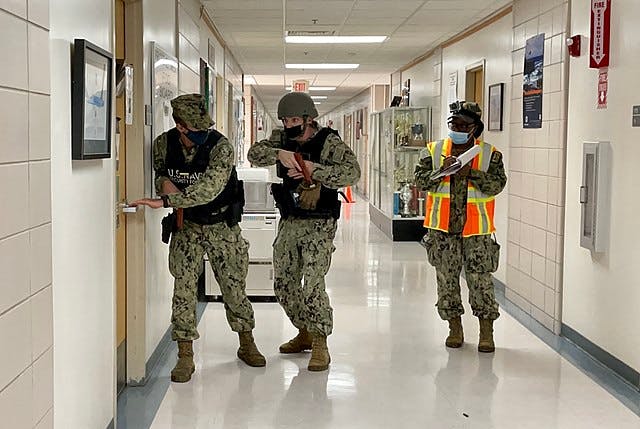How to Prepare Your Personnel with Active Shooter Training for Emergency Situations
How to Prepare Your Personnel with Active Shooter Training for Emergency Situations
Blog Article
Applying Active Shooter Training: Best Practices for Creating a Safe and Prepared Community Atmosphere
As neighborhoods confront the distressing reality of active shooter incidents, the implementation of extensive training programs becomes critical. An effective technique depends upon not just the development of customized educational programs that address local risks however also the involvement of diverse stakeholders. By utilizing a variety of training techniques, communities can ensure that all members are equipped with necessary abilities. The challenge lies in preserving an adaptive framework that progresses with emerging threats. What are the crucial aspects that can transform a basic training program right into a durable design for neighborhood durability?

Recognizing the Requirement for Training
In a period noted by raising events of violence in public areas, understanding the demand for energetic shooter training has never been more essential. Comprehensive training initiatives can furnish participants with the understanding and skills to respond decisively.
Training fosters a sense of empowerment and preparedness, enabling individuals to really feel more protected in their environments. The advantages of active shooter training prolong beyond immediate feedback; they include improving communication protocols and improving general safety and security measures within organizations.
Key Parts of Effective Programs
Effective active shooter training programs integrate a number of essential parts that enhance preparedness and reaction abilities. Thorough curriculum growth is essential, making certain that training material is relevant, evidence-based, and tailored to the particular demands of the organization or community. This consists of recognizing the dynamics of energetic shooter events and the emotional influence on individuals entailed.
Second, practical training situations need to be employed to mimic potential circumstances, enabling individuals to exercise decision-making and feedback strategies in a regulated environment. These drills help with muscular tissue memory and develop self-confidence amongst individuals.
Third, an emphasis on interaction methods is vital. Establishing clear lines of interaction amongst regulation enforcement, emergency responders, and participants makes certain collaborated feedbacks during an occurrence. Routine updates and correspondence course help maintain interaction paths clear and efficient.
Fourth, recurring evaluation and feedback systems need to be integrated into the training program - active shooter training. Analyzing the efficiency of training through participant comments and efficiency metrics permits for continuous renovation
Last but not least, promoting a culture of security and preparedness within the neighborhood urges vigilance and aggressive actions, making certain that individuals are not just skilled however likewise involved in maintaining a safe setting.
Engaging Community Stakeholders

To successfully engage these stakeholders, it is necessary to communicate the objectives and advantages of the training. Hosting informational sessions can assist clarify the training's objective, address issues, and describe the duties each stakeholder might play. Furthermore, producing a stakeholder advising committee can promote recurring dialogue, enabling for diverse perspectives and insights to be integrated into the training program.
Structure connections with neighborhood leaders and companies is additionally important. Their assistance can improve outreach efforts, increase involvement, and guarantee that training is tailored to the distinct requirements of the neighborhood. Furthermore, stakeholders can help in disseminating details and resources, enhancing the message of security and preparedness.
Eventually, involving neighborhood stakeholders not only reinforces the training campaign but likewise grows a feeling of ownership among citizens, leading to a much more resistant and informed neighborhood with the ability of responding properly to potential hazards.
Training Shipment Methods
Making use of a selection of training delivery techniques is vital to accommodate the diverse knowing styles and requirements of participants in active shooter training programs (active shooter training). Reliable training can take numerous kinds, including lectures, hands-on simulations, on the internet components, and interactive workshops. Each approach serves a distinct function and can improve the total knowing experience

Online modules supply versatility and availability, enabling individuals to find out at their very own speed. These can consist of video clips, quizzes, and conversations to determine understanding. Interactive workshops motivate seminar and problem-solving, promoting synergy and communication abilities.
Integrating a blended approach that incorporates these methods not only enhances the training experience yet likewise ensures that individuals are better prepared to respond efficiently in case of more information an active shooter circumstance (active shooter training). By addressing different discovering choices, organizations can produce a more educated and receptive community
Constant Examination and Enhancement
Routine analysis and enhancement of active shooter training programs are important to preserving their importance and effectiveness. As risks develop, so should the techniques and techniques used in training. Continual assessment guarantees that training material mirrors the newest intelligence on active shooter incidents, integrating lessons learned from current events and adjusting for emerging patterns.
To promote this procedure, companies need to develop responses systems that include participant evaluations, expert testimonials, and case debriefs. Accumulating information on participant efficiency during drills and exercises is crucial, as it highlights locations requiring enhancement and educates future training sessions. In addition, engaging with police and emergency situation responders can give useful insights right into the practicality and applicability of training protocols.
Regularly scheduled reviews of training materials and strategies should be mandated, cultivating an atmosphere of innovation and adaptability. Organizations has to also motivate a culture of continuous knowing, where staff participants really feel encouraged to suggest modifications based upon their experiences. By dedicating to continuous evaluation and enhancement, organizations not just improve the effectiveness of their active shooter training programs yet likewise strengthen their overall commitment to security and readiness within the neighborhood.
Verdict
To conclude, efficient implementation of energetic shooter training necessitates a thorough method that prioritizes area engagement and realistic simulations. By establishing tailored educational programs, including diverse training approaches, and promoting collaboration amongst stakeholders, neighborhoods can enhance preparedness. Continuous assessment and comments mechanisms wikipedia reference are vital for adjusting programs to arising threats, thus enhancing general safety. Inevitably, a dedication to continuous training and renovation grows a culture of alertness and preparedness, making certain a safer setting for all community participants.
Report this page